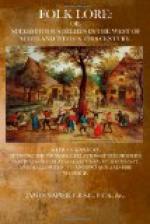“You have skill of man and
beast,
Ye was born between the Beltans.”
In all probability the discrepancy as to the day originated through the Church substituting a Christian festival for a heathen one; and although the date was changed, yet through force of custom the name of the old festival was retained, and in localities where the power of the Church was comparatively weak, the older, the original day for the festival would probably be kept as well as the newly appointed Church festival. This view of the matter is rendered probable from the fact that the Church did institute a great festival, to be held on the third of May, to commemorate the finding of the cross of Christ. The legend is as follows:—When the Empress Helena was at Jerusalem about the end of the third century, she discovered the cross on which Christ was crucified, and had it conveyed to the great church built by Constantine her son. This cross was exhibited yearly to the people, and many miracles were wrought by it. A festival, as I have said, was instituted in commemoration of the discovery, and this was held on the third of May, and was called Rood or rude day. Churches were built and dedicated to the Holy Rood, among which was that which is now Holyrood Palace. Where the Church was powerful, as in Edinburgh and Peebles, Rood day would be the important festival, and Beltane would gradually become incorporated with it, the names Beltane day and Rood day becoming synonymous. Thus we may account for Edinburgh and Peebles keeping Beltane on the third day of May, while in Perth and other northern counties where the Church influence was weaker, the festival would be kept according to the older custom on the first of May.
In Druidical times the people allowed their fires to go out on Beltane eve, and on Beltane day the priests met on a hill dedicated to the Sun, and obtained fire from heaven. When the fire was obtained, sacrifices were offered, and the people danced round the fire with shoutings till the sacrifices were consumed; after which they received portions of the sacred fire with which to rekindle their hearths for another twelve months. Besides mountains, there were evidently other localities where sacrifices and the ritual of Sun-worship were observed, and which received appropriate names in accordance with their character as sacred places. Some of these names still survive, as for instance:—
Ard-an-teine—The light of the fire.
Craig-an-teine—The rock of the fire.
Auch-an-teine—The field of the fire.
Tillie-bet-teine—The knoll of the fire; and so through a great many other names of places we find traces of the Baal and fire worship. So widespread and numerous are the names which recall this ritual, that we can see quite clearly that the spirit of their religion thoroughly dominated the people. In Ireland, at Beltane, the Pagan Kings are said to have convoked the people for State purposes. The last of these heathen kings convoked a grand assembly of the nation to meet with him on Tara, at the feast of Beltane, which the old chroniclers say was the principal feast of the year.




